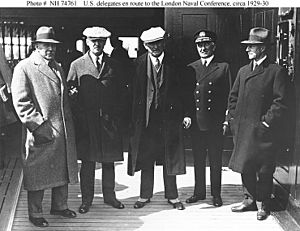London Naval Treaty facts for kids
| International Treaty for the Limitation and Reduction of Naval Armament | |
|---|---|

Members of the United States delegation en route to the conference, January 1930
|
|
| Type | Arms control |
| Context | World War I |
| Signed | 22 April 1930 |
| Location | London |
| Effective | 27 October 1930 |
| Expiration | 31 December 1936 (Except for Part IV) |
| Negotiators |
|
| Signatories | |
| Parties | |
| Depositary | League of Nations |
| Language | English |
The London Naval Treaty was an important agreement signed on April 22, 1930. It was made between five major world powers: the United Kingdom, Japan, France, Italy, and the United States.
This treaty aimed to control the size and power of navies around the world. It was a follow-up to the 1922 Washington Naval Treaty. That earlier treaty had set limits on large warships. The new London Treaty focused on submarines, cruisers, and destroyers. It also set rules for building new naval ships.
The treaty officially started on October 27, 1930. However, it didn't fully stop countries from building up their navies. It was recorded in the League of Nations Treaty Series on February 6, 1931.
Contents
Why the Treaty Was Needed
After World War I, countries wanted to avoid another costly arms race. An arms race is when countries compete to build more and more weapons. The Washington Naval Treaty helped limit battleships. But other types of warships still needed rules.
Leaders tried to reach an agreement at the 1927 Geneva Naval Conference. But they couldn't agree because of disagreements between Britain and America. Later, US President Herbert Hoover and UK Prime Minister Ramsay MacDonald talked in 1929. These talks helped set the stage for the London Conference. Many factors and other nations also played a part in the discussions.
What the Treaty Decided
The London Naval Treaty set specific rules for different types of warships. It tried to limit how many ships each country could have.
Submarine Limits
The treaty limited the size of submarines. Most submarines could be no more than 2,000 tons. Each major country could have three larger submarines, up to 2,800 tons. France was allowed to keep one even larger submarine.
The size of submarine guns was also limited for the first time. Guns could be no bigger than 6.1 inches. One French submarine was allowed to keep its 8-inch guns. This rule stopped the idea of building submarines with very large guns.
Cruiser Limits
The treaty created two types of cruisers:
- Light cruisers: These had guns up to 6.1 inches.
- Heavy cruisers: These had guns up to 8 inches.
The number of heavy cruisers was limited for each country:
- Britain: 15 ships, totaling 147,000 tons.
- America: 18 ships, totaling 180,000 tons.
- Japan: 12 ships, totaling 108,000 tons.
For light cruisers, there wasn't a limit on the number of ships. But there were total tonnage limits:
- America: 143,500 tons.
- Britain: 192,200 tons.
- Japan: 100,450 tons.
Destroyer Limits
Destroyers were defined as ships under 1,850 tons. Their guns could be up to 5.1 inches.
- America and Britain: Each could have up to 150,000 tons of destroyers.
- Japan: Could have up to 105,500 tons of destroyers.
Rules for Submarine Warfare
Article 22 of the treaty set rules for how submarines should act in wartime. It said that submarines must follow international law, just like surface ships.
It also stated that if a merchant ship (a ship carrying goods) refused to stop or fought back, it could be sunk. But only if the crew and passengers were first taken to a safe place.
Smaller Warships
The treaty also talked about smaller surface ships. Ships between 600 and 2,000 tons were usually exempt from limits. These ships could have guns up to 6 inches. They could also have up to four guns larger than 3 inches. They could not have torpedoes and had to be slower than 20 knots. These rules were made to fit ships like the French Bougainville-class avisos.
Warships under 600 tons were completely exempt from any limits. This led countries like Italy, Japan, France, and Britain to build many small, fast ships. They tried to use these smaller ships to get around the treaty's limits.
What Happened Next
After the London Naval Treaty, countries continued to discuss naval arms control. The Second Geneva Naval Conference was held in 1932. That year, Italy removed many of its battleships, cruisers, destroyers, and submarines from active service. This was about 130,000 tons of naval vessels.
Discussions among the treaty countries continued for several years. This led to the Second London Naval Treaty in 1936.
Images for kids
See also
- Treaty for the Limitation of Naval Armament
- Washington Naval Treaty
- Second London Naval Treaty – List of treaties signed in London.
- Treaty of London – List of treaties signed in London.
- May 15 Incident – attempted coup in Japan


